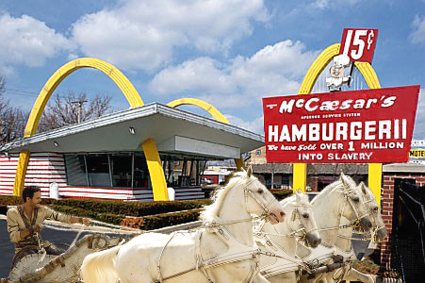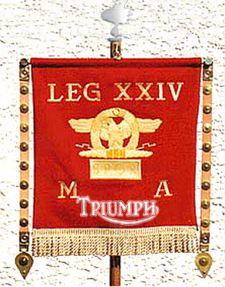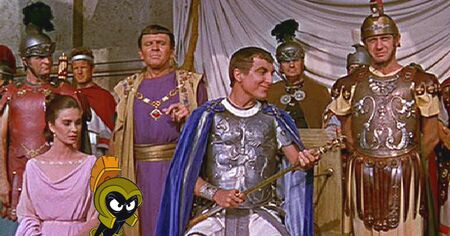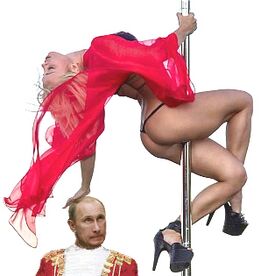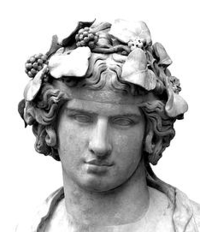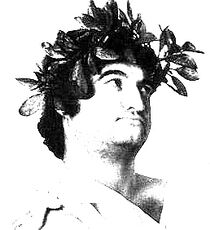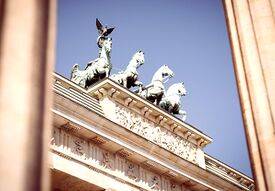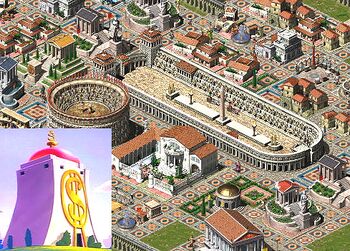Triumphus
A triumphus (English: triumph) was a celebration of a military victory by the Roman Empire. It consisted of a procession for the winning commander, an awards ceremony and feast.
"Triumph" is now synonymous with any victory, like unknotting one’s shoelaces. Or maybe just one lace so you can kick off one shoe and hang the other off the bed to finally go to sleep. It has become such a common term that automobiles, motorcycles and dogs are now named Triumph.[1]
Early triumphs[edit]
The first triumphal celebrations were held to honor a military commander that had successfully led his legion to victory in a full war campaign often lasting years.
The focus was the triumphal procession, where parade participants first gathered at the Campus Martius. After a time, it was decided Cleveland was too far away so the assembly point was moved to an empty field outside Rome.
The processions began as small events. In an early victory over the Picts, 200 captives were marched several times around the block to make it look like thousands had been captured.
Also in the early days, all spoils of war[2] were put on display. This means if a castle or bridge was captured, it was dutifully dragged through the streets of Rome. These were soon replaced by paintings or models after Cassius Claius Punchibus Maximus seized the western Mediterranean Sea and was given a triumph/triumphus. Half the entire sea was carried in buckets down the Via Victoria but so many citizens and slaves were needed for that, there was no one left to watch the parade.
A victorious commander was clothed in special garments and facepaint, a tradition begun by Puer Georgius, and rode in a 4-horse chariot called a quadriga.[3] A friend or slave rode with him to remind the commander to remain humble. He would whisper in the general’s ear phrases like "Remember there’s a cleaning charge if you get that robe[4] dirty". "Slow down, watch out for that street urchin". "Did you remember to bring the scroll with your speech?" And "Hey, don’t push me off the chari-- ".
The general was then presented to the emperor who awarded him a laurel wreath, and couponii worth hundreds of solidii in discounts. Following was an autograph session with fans allowed to pose for statues with the commander for an extra charge. The general was then feted with a grand banquet. He retired the next day to become a priest for the god Lockheed.[5]
Later triumphs[edit]
As egos grew, so did the victory celebrations. The triumphus eventually evolved and devolved into a massive formalized occasion by the time of the Roman Republic and the late period of the Roman Empire.
Procession[edit]
- Parade of chickens. Pliny the Younger reported seeing thousands of chickens marching in lockstep and clucking in unison.[6]
- Parade of slaves. These could be arranged by size or color, sometimes by size or color of chains.
- Parade of captured barbarians. Before entering Rome, they were made to fashion uniforms of a sort and were quickly taught to play musical instruments to add to the pageantry. Captured Trojans are still remembered for their song Conquest[7], and so were sent to a well-deserved immediate execution.
- Display of captured barbarian leaders. They were shackled to floats and forced to throw strings of cheap beads and fake coins to the crowds. Oleus Rex Dolorous Miamus or The Horrible Burger King of the Miami tribes was particularly reviled, a perennial figure in triumphal parades due to Rome’s failed catch-and-release program.
- Appearance of dignitaries. Senate members and the famous would often walk to give the impression of humility, though in actuality most were being carried along by midget slaves. Major dignitaries would ride horses, though often only their horses appeared, emblazoned with the dignitary’s name. The crowd showed their respect by turning around and saluting the senators with the gluteus maximus lunares, a now forgotten practice thought to somehow involve Moon worship.[citation needed]
- Procession of beasts. Captured exotic animals were displayed to the awe and wonder of the masses. It took years before the lions and tigers[8] were put in cages, as the crowds always got a thrill from being chased down by loose hungry animals. Elephants were always a popular draw until a team of them pulling Pompey the Semi-Great’s quadriga got stuck in the triumphal gate, prompting the first utterance of “What’s holding up the parade?".
- Return of the slaves. This time with brooms to clean up after the animals and remove any half-eaten spectators. Often this took very little time since revelers had already taken most of what needed cleaning up for souvenirs.
- March of the victorious army. Always met with an incredible roar, the army reciprocated by hurling souvenir javelins and missiles into the throngs, following that with volleys of souvenir arrows.[9]
- Ride of the victorious general and his staff. The general rode in the now-traditional quadriga, in later years equipped with reflective mudflaps and spinner hubcaps. His subordinate generals followed in 2-horse chariots, followed by acolytes of the Shrine of Rome on miniature Shetland ponies weaving crazily behind.
- Appearance of Santa Claus’s float.
This would then be followed by the singing of the Roman Anthem, performed for decades by Roseanna Barrus, insuring the streets of central Rome would be cleared in minutes so that cleaning could commence.[10]
Religious obligations[edit]
The victorious general and his staff, joined by select members of the Senate, would continue on to perform required religious duties.
- The first stop would at the Temple of Jupiter to offer gifts and sacrifices in thanks.
- The next was to go to the Temple of Mars to also offer gifts and sacrifices.
- Following that, a visit was made to the Temple of Bacchus to pick up a few amphorae of wine.
- Next was a trip to the Temple of Flora for the festival of commemorative dancing.
- This was followed by a jaunt to the Temple of Venus Erycina for the usual reasons.[citation needed]
- After downing a few amphorae of wine, another trip was made back to the Temple of Venus Erycina.
- As three was a lucky number to Romans, another visit was made to the Temple of Venus Erycina. [11]
Awards[edit]
In the forum before huge crowds, the highest ranking senators would present the commander with many awards and gifts. A gold laurel wreath would be placed on his head. Then, praetor Picmi Montius Praetorium would offer a choice between an object in a box, something behind a curtain or 1500 denarii in cash. A correct choice could gain the commanding general enough to be set for life.[12] The clunker prize was originally an orange. In later years, it was an exotic imported fruit called a banana, to be used as the only weapon in a mandatory contest against gladiator Ignatius Russellus Corvus in the Colosseum.[13]
The ceremony closed dramatically. Anointed by Jupiter himself, a midget carrying a cream pie ran the length of the Forum to smoosh it into the commander’s face, just to show who was boss.
In 53CE, citizens rioted in the streets over allegations of bribery, rigging of results in the award ceremony, as well as questions about the type of cream pie used in the closing ceremony. After long deliberation, the Senate wisely[14] decided to punish the guilty by forbidding them doughnuts for a week while any rioters protesting the decision would be sentenced to a lifetime of hard labor in the mines of Moria.
Feast[edit]
A gigantic banquet for the upper ranks and dignitaries was a favorite feature of triumphal celebrations, sometimes held in leaner years in the Great Hall of the Golden Corral (Latin: Praetorium magna fons chocolatus pestilentum). All manner of delicacies were proffered. A legendary but now-lost dish called Turducken was a favorite though its preparation was responsible for massive fires that swept the city.
In 84CE, Raimondus Gaius Julius Septimus Croccus presented a special dish to only be served at triumphal banquets. This was the Maccus Biggus, with 2 all-beef patties made from sacrificed cattle, special sauce,[15] lettuce, cheese, etc., etc.
As a celebration progressed, it fell into the drunken debauchery storied in film and print. Modern people now think that even a Roman snacktime was punctuated by raunchy sex and the worst drunken destruction possible. While this is common today, Romans were a more practical people, only going overboard when they knew somebody else was footing the bill.
Yet some merely attended the feast for an hour or two and went back to the quiet life again[16] The religious and conservative Senator Johannus Antonius Oblivious Marcellus Blutarskis would normally shun the triumphal banquet orgy of excess in favor of visits to the Temple of Venus Erycina alternating with worship at the Temple of Bacchus and sometimes the Temple of Nepenthe.
The party could continue for days, only ending when escaped slaves invaded the venue and terrorized the screaming guests with brooms that the authorities had forgotten to take back.
Meanwhile the army celebrated as it normally did in the provinces – drinking, looting and raping their way through Rome.
Triumphal arch[edit]
While the original commemorative monument was just a granite block, conquering armies tended to try to march through or over it while on parade. At the suggestion of the aforementioned Raimondus Gaius Julius Septimus Croccus, they were then built as an arch for triumphal armies to pass through. In exchange, a grateful senate awarded the food concession in the arch to Croccus. The enterprising citizen then would post an updated count of Roman victories at each arch location. Further, the victorious commander’s quadriga would be enshrined at the top of the arch with statuary added. As a final touch, the Maccus Biggus would be served to any citizen who asked.[17] These structures were built to last and many survive today.
This style of monument would be carried on by later nations to commemorate triumphs. France's Arc de Triomphe (English: Arc de Triomphe) was begun by Napoleon I to commemorate his victory at Austerlitz. Germany's Brandenberger Tor (English: Brandenberg Gate, or "Berlin Gate thing to be photographed") was erected to commemorate the suppression of the Batavian Revolt. The former serves pommes frites with its Royales, the latter offers Berliners (jelly doughnuts) with its Brandenburgers. The Triumphal Arch of Pyongyang, North Korea, was built for the hell of it, and serves kimchi with its featured kimchi, all made by Kim Jong-un's grandma serving a thirty-year prison sentence.[18]
Consequences[edit]
The great cost and devastation caused by days of triumphal partying soon exceeded the value of any loot gained from conquest and hastened the end of the Empire. Every general demanded a triumphus for any minor skirmish won, even with the neighbors or the family dog. Triumphii became so common that the Senate decreed there would be only one triumph per month shared by generals having a battle victory in that month. Economic pressures dictated that there would be no more feasts, just a store-bought cake with the generals' names on it. This led to army rebellions in outer provinces and a boycott of the Secret Santa program in the upper ranks.
The Roman treasury was so depleted that citizens paid the ultimate price with tens of thousands dying of starvation in the more remote provinces. In solidarity with the people's plight, the Roman Senate reduced their quarterly six-week vacations to just three,[19] and generously raised taxes by a token 30%.
The end came when Huns came to the areas around Rome to raise and sell rabbits for food.[20] Expecting the Romans to hold a triumphus for them, it was explained there was no cash in the treasury for it and that the Huns should return to the northern provinces.[21] With Huns and their rabbits protesting in front of the senate, frightened senators threw hot cross buns at them from the roof in an attempt to appease them.[22] The situation and the resultant icky dialogue disgusted the nearby Visigoth[23] tribes, who were expecting a triumphus for themselves. The Visigoths took matters into their own hands and went out and solicited funds on streetcorners. The coins would be collected daily and emptied into one large bag, known as the sack of Rome.
Footnotes[edit]
- ↑ "Wretched is he who embeds references to his own articles in another" – Cato the Elder.
- ↑ Hoogh! What is it good for? Absolutely Fabulous!
- ↑ Rented from the local Junius Snobbus Eldoradus Cadillacus dealership for the occasion.
- ↑ See The Robe (1953 movie).
- ↑ Still done today.
- ↑ It should be noted that Pliny was already in a bar for several hours by this time.
- ↑ Written by barbarian Alfred "No E" Newman.
- ↑ Oh, my!
- ↑ AAAAAAAAA!
- ↑ Plebs! More plebs are needed!
- ↑ This demonstrates the very pious nature of upper class Romans.
- ↑ About 3 more years at this time in history.
- ↑ Sunday!! Sunday!! Sunday!!
- ↑ After bribes
- ↑ Everyone knew it was just garum and mayo.
- ↑ Japan, Quiet Life single, (1979).
- ↑ By law, slaves could only eat real food.
- ↑ And you'd better like it, or else.
- ↑ See Roman Holiday (1953), starring Audrey Hepburn and Pontius Pilate.
- ↑ Therefore, the phrase still used today, Hunny Bunny.
- ↑ No money, no Hunny.
- ↑ No money no Hunny, Hunny Bunny honey buns.
- ↑ Inventors of Visine and Visicalc.
